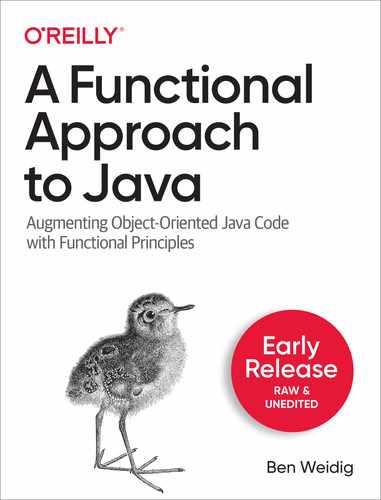Java developers usually tackle the complexity of software development through object-oriented programming (OOP). But not every problem is a good match for OOP. The functional programming (FP) paradigm offers you another approach to solving problems, and Java provides easy-to-grasp FP tools such as lambdas and streams. If you're interested in applying FP concepts to your Java code, this book is for you. Author Ben Weidig highlights different aspects of functional programming and shows you how to incorporate them in your code without going "fully functional." You'll learn how, when, and why to use FP concepts such as immutability and pure functions to write more concise, reasonable, and future-proof code. Many developers seek to expand their horizons by using OOP and FP together. It's no longer either-or; it's both. In two parts, this book includes:
Table of Contents
- Preface
- New Hardware Needs a New Way of Thinking
- Why Java?
- Why I Wrote This Book
- Who Should Read This Book
- What You Will Learn
- What About Android?
- Android is (not) Java
- Desugaring Android Java Code
- A Functional Approach to Android
- Navigating This Book
- Conventions Used in This Book
- Using Code Examples
- O’Reilly Online Learning
- How to Contact Us
- Acknowledgments
- I. A Functional Approach
- 1. An Introduction to Functional Programming
- The Origin of Functional Programming
- Lambda Abstractions
- Application
- Reduction
- What is Functional Programming?
- Expressions
- Statements
- Functional Programming Concepts
- Pure Functions
- Referential Transparency
- Immutability
- Recursion
- First-Class and Higher-Order
- Functional Composition
- Laziness
- Advantages of Functional Programming
- Academia Versus “The Real World”
- Takeaways
- 2. Optionals
- How to Handle null
- Best Practices and Informal Rules
- Safe Navigation Operator
- Embrace null as valid value
- Third-party tools
- No null at all and/or specialized types
- How Java Handles null with Optionals
- Optional<T> Operations
- Creating Optionals
- Checking for Values
- Filtering and Mapping
- Getting a (fallback) value
- Optional Primitives
- Creating an Improved Primitive Wrapper
- Using Your Own Optional Types
- Optionals and Streams
- Optionals as Stream Elements
- Terminal Operations
- Caveats
- Special Considerations for Collections
- Alternative Implementations
- Is null Really Evil?
- Takeaways
- 3. Recursion
